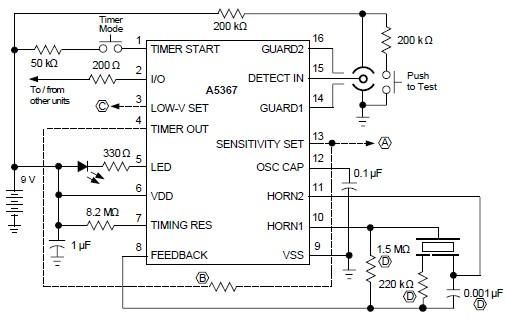
Product detector

The MC1596/MC1496 serves as an effective single sideband (SSB) product detector. This detector exhibits a sensitivity of 3 microvolts and a dynamic range of 90 dB while functioning at an intermediate frequency of 5 MHz. It is designed to operate over the entire high-frequency spectrum. For applications requiring very low intermediate frequencies down to 50 kHz, the capacitors on pins 7 and 8 should be increased to 1 µF. Additionally, the output filter connected to pin 9 can be customized to match a specific intermediate frequency and the input impedance of the audio amplifier. The emitter resistance between pins 2 and 3 can be adjusted to modify the circuit's gain, sensitivity, and dynamic range. Furthermore, this circuit can function as an AM detector by applying a carrier signal to the carrier input and an AM signal to the SSB input. The carrier signal may be sourced from the intermediate frequency signal or generated locally. It can be introduced with or without modulation, as long as its level is sufficiently high to saturate the upper quad differential amplifier. For modulated carrier signals, a recommended input level of 300 mV (rms) is suggested.
The MC1596/MC1496 integrated circuit is designed for versatility in signal detection applications. As an SSB product detector, it efficiently demodulates SSB signals by leveraging its high sensitivity and dynamic range, making it suitable for communications systems where signal integrity is crucial. The ability to operate effectively at an intermediate frequency of 5 MHz allows for integration into various radio frequency (RF) systems.
When configuring the circuit for lower intermediate frequencies, the adjustment of the capacitors on pins 7 and 8 to 1 µF is critical. This modification enhances the circuit's response characteristics, ensuring optimal performance across a broader range of frequencies. The output filter design at pin 9 is also essential; it must be tailored to accommodate the specific intermediate frequency being utilized and the input impedance of the subsequent audio processing stage. This customization ensures that the output signal maintains fidelity and minimizes distortion.
The adjustment of the emitter resistance between pins 2 and 3 provides a means to fine-tune the circuit's overall performance. By increasing or decreasing this resistance, the designer can achieve the desired balance between gain, sensitivity, and dynamic range, which is vital for adapting the circuit to various operational contexts.
Additionally, the capability of the MC1596/MC1496 to function as an AM detector expands its utility. By introducing a carrier signal at the carrier input alongside an AM signal at the SSB input, the circuit can demodulate amplitude-modulated signals. This dual functionality is particularly beneficial in systems where both SSB and AM signals need to be processed, allowing for a more streamlined design approach.
To ensure proper operation when using a modulated carrier signal, maintaining a sufficient input level of 300 mV (rms) is necessary to achieve saturation in the upper quad differential amplifier. This requirement underscores the importance of signal integrity in achieving accurate demodulation and maintaining the quality of the output signal. Overall, the MC1596/MC1496 integrated circuit provides a robust solution for advanced signal detection applications in modern communication systems.The MC1596/MC1496 makes an excellent SSB product detector. This product detector has a sensitivity of 3 microvolts and a dynamic range of 90 dB when operating at an intermediate frequency of S MHz. The detector is broadband for the entire high frequency range. For operation at very low intermediate frequencies down to 50 kHz the 0 /aF capacitors on pins 7 and 8 should be increased to 1 /aF.
Also, the output filter at pin 9 can be tailored to a specific intermediate frequency and audio amplifier input impedance. The emitter resistance between pins 2 and 3 may be increased or decreased to adjust circuit gain, sensitivity, and dynamic range
This circuit may also be used as an AM detector by introducing carrier signal at the carrier input and an AM signal at the SSB input. The carrier signal may be derived from the intermediate frequency signal or generated locally. The carrier signal may be introduced with or without modulation, provided its level is sufficiently high to saturate the upper quad differential amplifier.
If the carrier signal is modulated, a 300 mV (rms) input level is recommended.
The MC1596/MC1496 integrated circuit is designed for versatility in signal detection applications. As an SSB product detector, it efficiently demodulates SSB signals by leveraging its high sensitivity and dynamic range, making it suitable for communications systems where signal integrity is crucial. The ability to operate effectively at an intermediate frequency of 5 MHz allows for integration into various radio frequency (RF) systems.
When configuring the circuit for lower intermediate frequencies, the adjustment of the capacitors on pins 7 and 8 to 1 µF is critical. This modification enhances the circuit's response characteristics, ensuring optimal performance across a broader range of frequencies. The output filter design at pin 9 is also essential; it must be tailored to accommodate the specific intermediate frequency being utilized and the input impedance of the subsequent audio processing stage. This customization ensures that the output signal maintains fidelity and minimizes distortion.
The adjustment of the emitter resistance between pins 2 and 3 provides a means to fine-tune the circuit's overall performance. By increasing or decreasing this resistance, the designer can achieve the desired balance between gain, sensitivity, and dynamic range, which is vital for adapting the circuit to various operational contexts.
Additionally, the capability of the MC1596/MC1496 to function as an AM detector expands its utility. By introducing a carrier signal at the carrier input alongside an AM signal at the SSB input, the circuit can demodulate amplitude-modulated signals. This dual functionality is particularly beneficial in systems where both SSB and AM signals need to be processed, allowing for a more streamlined design approach.
To ensure proper operation when using a modulated carrier signal, maintaining a sufficient input level of 300 mV (rms) is necessary to achieve saturation in the upper quad differential amplifier. This requirement underscores the importance of signal integrity in achieving accurate demodulation and maintaining the quality of the output signal. Overall, the MC1596/MC1496 integrated circuit provides a robust solution for advanced signal detection applications in modern communication systems.The MC1596/MC1496 makes an excellent SSB product detector. This product detector has a sensitivity of 3 microvolts and a dynamic range of 90 dB when operating at an intermediate frequency of S MHz. The detector is broadband for the entire high frequency range. For operation at very low intermediate frequencies down to 50 kHz the 0 /aF capacitors on pins 7 and 8 should be increased to 1 /aF.
Also, the output filter at pin 9 can be tailored to a specific intermediate frequency and audio amplifier input impedance. The emitter resistance between pins 2 and 3 may be increased or decreased to adjust circuit gain, sensitivity, and dynamic range
This circuit may also be used as an AM detector by introducing carrier signal at the carrier input and an AM signal at the SSB input. The carrier signal may be derived from the intermediate frequency signal or generated locally. The carrier signal may be introduced with or without modulation, provided its level is sufficiently high to saturate the upper quad differential amplifier.
If the carrier signal is modulated, a 300 mV (rms) input level is recommended.





